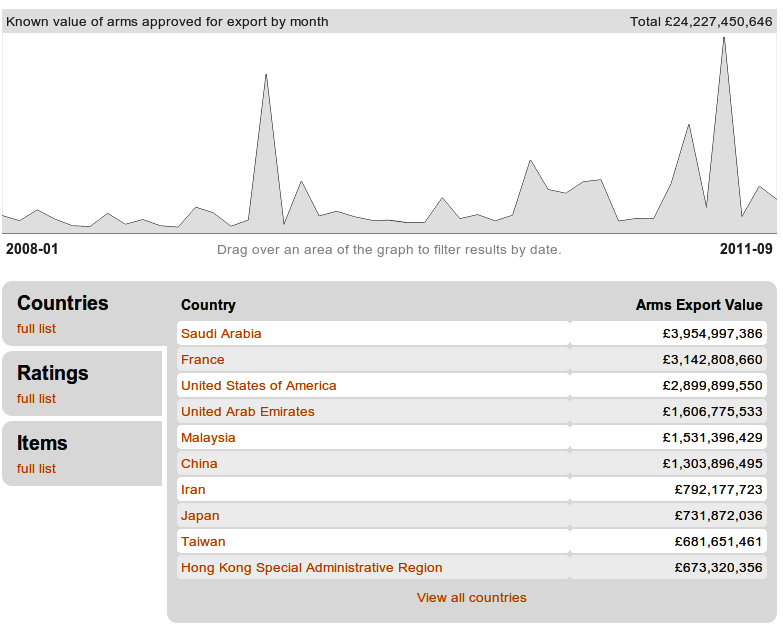Ian Mackinnon quit his job to create a ground-breaking web app that allows anyone to browse the licences granted by the UK government for exporting arms. Here he talks about why this work was so necessary.
I first came across the UK Government’s Export Controls web page out of curiosity. Among protesters organising against the DSEI arms fair there is often speculation about what arms deals might be done in private between British companies and representatives of repressive governments, but I wanted more concrete information.
I’d heard that the official export data had been made publicly available, so I thought I’d take a quick look and find out what was actually leaving the country, who our biggest buyers were, and what types of weapons unsavoury regimes were most interested in. I thought it would take a few clicks, but every step of the way there were barriers.
The data wasn’t visible on-line; it could only be downloaded bundled in large text documents. These in turn were not simply available, but had to be individually requested and “processed” for about 5 minutes each before a link would appear. To include a specific country in your search took three clicks, so to include all the countries it took about 750! Finally, you would receive a giant document of several hundred pages, which you could start scouring for relevant figures buried among jargon and undefined acronyms. All this for data from one short time period, and there were thousands of periods available. This was not the realm of open government data I was hoping for.
I was frustrated, both at not being able to find answers to my own simple questions after a whole afternoon’s work, and at the thought that researchers and campaigners with far more use for the data than me might also be wasting their valuable time on so many unnecessary obstacles. Luckily for me, I am a computer programmer, and I saw this as something of a challenge.
I began writing a program to automate downloading of every document available, and as soon as I was able to leave it running by itself I called the Campaign Against Arms Trade office and asked if I could meet with someone to discuss what I hoped would be a worthwhile project.
The staff were enthusiastic, and told me about their ongoing negotiations with the Export Control Organisation to provide better and more accessible data. It sounded like a slow process, but I was confident that we could go a long way towards improving the situation by ourselves. Over the following weeks I received from CAAT all the help and explanations needed to start building software that could prise the figures out of the mountain of documents I had accumulated and put them into some kind of logical order.
I was getting somewhere, but the amount and complexity of the data was vast. As uprisings and retaliatory repression were escalating throughout the Middle East, and British ministers were still busy promoting weapons sales in the region, the export information seemed more important than ever, so in December I decided to quit my job to pursue the project full time. By then we had the clear goal: to build our own web application which would make the data available to anyone, quickly and clearly.
We had a list of specifications, each one a failing of the Government site that we wanted to resolve:
- No registration required – anyone can see the data without having to supply any personal details
- Show the biggest recipient countries and the most common exports at a glance
- Quick searches by country, item or type of licence
- Every search must be addressable so it can be shared or bookmarked
- Make the figures more digestible with graphs
- Explain all terminology with roll-over descriptions.
- Conform to accessibility standards for users with visual or physical impairments
- Provide a full dump of the raw data in machine readable format for other researchers
- Speed – users must be able to find what they’re looking for in seconds, not weeks!
At the beginning of March we launched our application, which was enthusiastically received and widely visited – no small thanks to an outing in the Guardian datablog. It was especially rewarding to see campaign groups for specific conflict-stricken regions pick up the relevant figures almost immediately, and share their findings across the web. I also personally learned a valuable lesson that it’s worth trying to fix things that aren’t working even if they initially seem outside of one’s control.
CAAT is still continuing negotiations with the Export Control Organisation, but I hope that we’ve shown them there’s no excuse for not providing clear and accessible data about arms exports to everyone. I believe we’re all responsible for our Government’s actions, and transparency is absolutely necessary if we’re to do our part guiding them in the right direction.
When Ian’s app was launched, the CAAT website received the most traffic it has ever had – over 41000 page views in one day.


